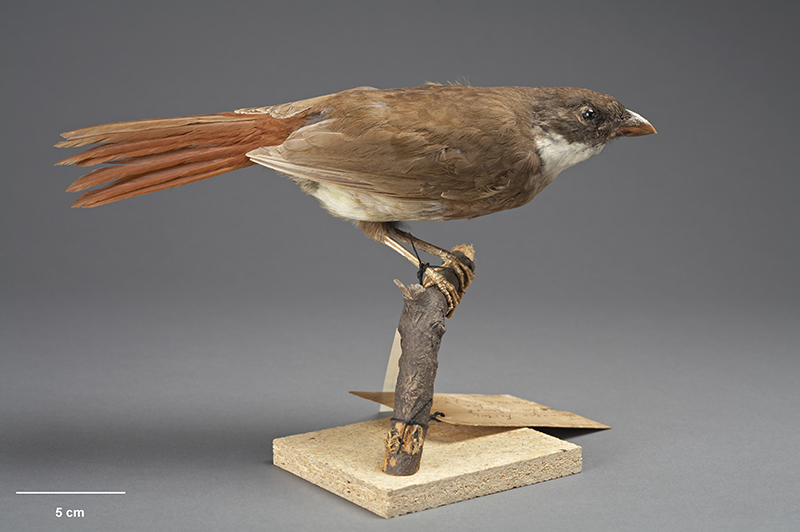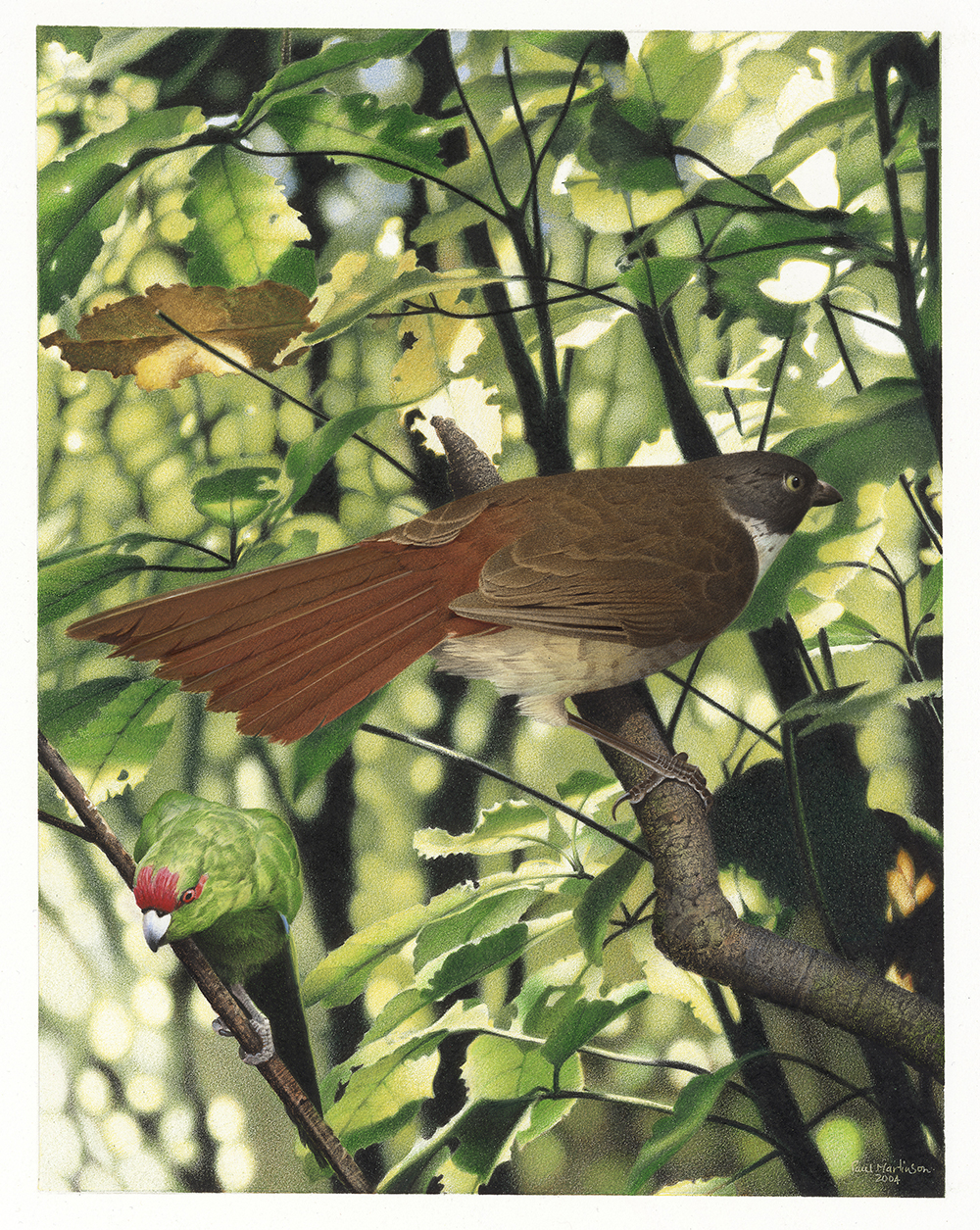Turnagra tanagra Schlegel, 1865/6
North Island piopio, North Island native thrush, Piopio (Māori)
Taxonomy & Nomenclature
A complete synonymy taken from (Checklist Committee (OSNZ), 2022:212):
Otagon tanagra Schlegel, 1866: Ned. Tijdsch. Dierk. 3: 190 – no locality = North Island (fide Checklist Committee 1953, Checklist N.Z. Birds: 68).; Keropia tanagra (Schlegel); Finsch 1870, Journ. für Ornith. 18: 323.; Turnagra tanagra (Schlegel); Mathews & Iredale 1913, Ibis 1 (10th series): 445.; Turnagra capensis tanagra (Schlegel); Checklist Committee 1953, Checklist N.Z. Birds: 68.; Turnagra hectori Buller, 1869: Ibis 5 (new series): 39 – North Island.; Turnagra Hectori Buller; Anon. 1870, Cat. Colonial Mus.: 73.
Johansson et al. (2011) has shown that Turnagra belongs to ORIOLIDAE, and not its own family (TURNAGRIDAE) which has been the general trend up until now.
Conservation Status
Extinct
Last record: 1902 (specimen); 1955 (Kittelberger et al., 2024); up until 1970 (unconfirmed reports)
IUCN RedList status: Extinct
The last specimen was collected in 1902 (BirdLife International, 2016), apparently at Ohura. At least one expedition has been mounted in search of the species, from February 26 to March 5, 1949, which failed to find it's target (Annabell, 1949). However, numerous post-1902 unconfirmed sightings have reported, up until at least 1970. The list includes at least the following:
- 1917 (Mead, 1950:5)
- 1922 or 1923 (Mead, 1950:5)
- 1930 (Mead, 1950:5)
- 1933 (Olsen, 1993)
- May 1946 (Sopp, 1957)
- 11 November 1952 (Sopp, 1957)
- 9 April 1953 (Sopp, 1957)
- 9 April 1955 (Sopp, 1957)
- March 1970 (Bell & Singleton, 1974)
Fleming et al. (1953) contains at least one sighting report (fide Williams, 1962:20)
Distribution
North Island, New Zealand
Biology & Ecology
Hypodigm
Twenty seven museum specimens were known in 1968:
"[S]eventeen are in New Zealand, three in Holland (i.e. the Netherlands), three in the United States of America, two in England, one in Austria and one in Australia" (Medway, 1968).
Museum of New Zealand Te Papa Tongarewa:
OR.000212 (collected 8 September 1900)
All three Holland specimens are in the Naturalis Museum, and include the holotype:
[url=http://nlbif.eti.uva.nl/naturalis/detail.php?lang=uk&id=34]RMNH 89869[/url] (adult) [holotype]
[url=http://nlbif.eti.uva.nl/naturalis/detail.php?lang=uk&id=34]RMNH 110.054[/url] (female)
[url=http://nlbif.eti.uva.nl/naturalis/detail.php?lang=uk&id=34]RMNH 110.055[/url] (female)
Other specimens:
NZA6190 (Holdaway et al., 2002)
Media

Above: North Island Piopio, Turnagra tanagra, collected 8 September 1900, Waitotara district, New Zealand. CC BY 4.0. Te Papa (OR.000212)

Above: North Island Piopio. Turnagra tanagra. From the series: Extinct Birds of New Zealand., 2005, Masterton, by Paul Martinson. Purchased 2006. © Te Papa. CC BY-NC-ND 4.0. Te Papa (2006-0010-1/13)
References
Original scientific description:
Schlegel, Hermann. (1866). [description of Turnagra tanagra]. Nederlandsch Tijdschrift voor de Dierkunde 3: 190.
Other references:
Annabell, A. R. (1949). Quest for native thrush. Notornis 3(6): 156.
Anonymous. (1964). List of rare birds, including those thought to be so but of which detailed information is still lacking. IUCN Bulletin 10(Special Supplement): 4 pp.
Arkive website. Turnagra tanagra factsheet (http://www.arkive.org/north-island-piopio/turnagra-tanagra/) Dowloaded on 11 September 2011.
Bell, R. and Singleton, L. (1974). A sighting of the Piopio or Native Thrush. Notornis 21(3): 268-269.
BirdLife International. (2016). Turnagra tanagra. The IUCN Red List of Threatened Species 2016: e.T22728820A94997902. https://dx.doi.org/10.2305/IUCN.UK.2016-3.RLTS.T22728820A94997902.en. Downloaded on 11 November 2017.
Brooks, T. 2000. Extinct species. In: BirdLife International (ed.), Threatened Birds of the World, pp. 701-708. Lynx Edicions and BirdLife International, Barcelona and Cambridge, U.K.
Buller, W. L. (1888). A history of the birds of New Zealand, 2nd edition. London: Self published.
Checklist Committee (OSNZ). (2010). Checklist of the Birds of New Zealand, Norfolk and Macquarie Islands, and the Ross Dependency, Antarctica (4th ed.). Ornithological Society of New Zealand & Te Papa Press, Wellington. [p. 285]
Checklist Committee (OSNZ). (2022). Checklist of the Birds of New Zealand (5th edition). Ornithological Society of New Zealand Occasional Publication No. 1. Wellington: Ornithological Society of New Zealand. [p. 212]
Christidis, L.; Leeton, P. R.; Westerman, M. (1996). Were bowerbirds part of the New Zealand fauna. Proceedings of the National Academy of Sciences USA 93: 3898-3901.
del Hoyo, J., Collar, N.J., Christie, D.A., Elliott, A., Fishpool, L.D.C., Boesman, P. and Kirwan, G.M. 2016. HBW and BirdLife International Illustrated Checklist of the Birds of the World. Volume 2: Passerines. Lynx Edicions and BirdLife International, Barcelona, Spain and Cambridge, UK.
Fleming, C. A. et al. (1953). Checklist of New Zealand birds. Wellington: A. H. & A. W. Reed.
Fuller, Errol. (1988). Extinct Birds. New York: Facts on File Publications. 256 pp.
Greenway, J.C. 1967. Extinct and vanishing birds of the world. Dover Publications, New York.
Holdaway, R. N. 1999. Introduced predators and avifaunal extinction in New Zealand. In: MacPhee, R.D.E. (ed.), Extinctions in near time: causes, contexts and consequences, pp. 189-238. Plenum Press, New York.
Holdaway, Richard N., Roberts, Richard G., Beavan-Athfield, Nancy R., Olley, Jon M. and Worthy, Trevor H. (2002). Optical dating of quartz sediments and accelerator massspectrometry 14C dating of bone gelatin and moa eggshell: a comparison of age estimates for non-archaeological deposits in New Zealand. Journal of The Royal Society of New Zealand 32(3): 463-505.
Holdaway, Richard N., Worthy, Trevor H. and Tennyson, Alan J. D. (2001). A working list of breeding bird species of the New Zealand region at first human contact. New Zealand Journal of Zoology 28: 119-187.
del Hoyo, J., Collar, N.J., Christie, D.A., Elliott, A., Fishpool, L.D.C., Boesman, P. and Kirwan, G.M. 2016. HBW and BirdLife International Illustrated Checklist of the Birds of the World. Volume 2: Passerines. Lynx Edicions and BirdLife International, Barcelona, Spain and Cambridge, UK.
Johansson U. S., Pasquet, E. and Irestedt, M. (2011). The New Zealand Thrush: An Extinct Oriole. PLoS ONE 6(9): e24317.
Kittelberger, Kyle D., Tanner, Colby J., Buxton, Amy N., Prewett, Amira and Şekercioğlu, Çağan Hakkı. (2024). Correlates of avian extinction timing around the world since 1500 CE. Avian Research 15: 100213. https://doi.org/10.1016/j.avrs.2024.100213 [Supplementary data (List of 216 taxa)]
Knox, Alan G. and Walters, Michael P. (1994). Extinct and endangered birds in the collections of The Natural History Museum. British Ornithologists' Club Occasional Publications 1: 1-292. [p. 223]
Marples, B. K. (1946). List of the birds of New Zealand. Notornis 1(supp.): i-vii.
Mead, W. P. (1950). North Island Thrush. Notornis 4(1): 3-6.
Medway, David G. (1968). Records of the Huia, North Island Thrush and North Island Kokako from the diaries of Joseph Robert Annabell (1857-1924). Notornis 15(3): 177-192.
Medway, David G. (1971). Sub-fossil avian remains from the Awakino - Mahoenui area. Notornis 18(3): 218-219.
Oliver, W. R. B. (1955). New Zealand birds, 2nd edition. Wellington: A. H. & A. W. Reed.
Olsen, Malcolm. (1993). North Island Piopio - a possible 1930s record. Notornis 40(1): 26.
Olson, S. L.; Parkes, K. C; Clench, M. H.; Borecky, S. R. (1983). The affinities of the New Zealand passerine genus Turnagra. Notornis 30: 319-346.
Paulin, C. D. (1973). Sub-fossil avian remains from two limestone caves in North Taranaki. Mauri Ora 1: 95-98.
Robertson, H. A., Baird, K. A., Elliott, G. P., Hitchmough, R. A., McArthur, N. J., Makan, T. D., Miskelly, Colin M., O’Donnell, C. F. J., Sagar, P. M., Scofield, R. P., Taylor, G. A. and Michel, P. (2021). Conservation status of birds in Aotearoa New Zealand, 2021. New Zealand Threat Classification Series 36. Department of Conservation, Wellington. 43 pp.
Hugh Robertson, John Dowding, Graeme Elliott, Rod Hitchmough, Colin Miskelly, Colin O’Donnell, Ralph Powlesland, Paul Sagar, Paul Scofield, Graeme Taylor. (2013). Conservation status of New Zealand birds, 2012. New Zealand Threat Classification Series 4. 22 pp.
Sayol, Ferran, Steinbauer, Manuel J., Blackburn, Tim M., Antonelli, Alexandre and Faurby, Søren. (2020). Anthropogenic extinctions conceal widespread evolution of flightlessness in birds. Science Advances 6(49): eabb6095. https://doi.org/10.1126/sciadv.abb6095 [Supplementary Material (Data File S1)]
Scott, Peter (ed.). (1965). Preliminary List of Rare Mammals and Birds, pp. 155-237. In: The Launching of a New Ark. First Report of the President and Trustees of the World Wildlife Fund. An International Foundation for saving the world's wildlife and wild places 1961-1964. London: Collins.
Sopp, G. E. (1957). North Island Native Thrush or Pio-Pio (Turnagra capensis tanagra). Notornis 7(4): 101-102.
Tennyson, Alan J. D. and Martinson, Paul. (2006). Extinct Birds of New Zealand. Wellington: Te Papa Press.
Tyrberg, Tommy. (2009). Holocene avian extinctions, pp. 63-106. In: Turvey, Samuel T. (ed.). Holocene Extinctions. Oxford, UK & New York, USA: Oxford University Press. xii + 352 pp.
Williams, G. R. (1962). Extinction and the land and freshwater-inhabiting birds of New Zealand. Notornis 10(1): 15-32.
Worthy, Trevor H. and Holdaway, Richard N. (2000). Terrestrial fossil vertebrate faunas from inland Hawke's Bay, North Island, New Zealand. Part 1. Records of the Canterbury Museum 14: 89-154.
Worthy, Trevor H. and Holdaway, Richard N. (2002). The Lost World of the Moa: Prehistoric Life of New Zealand. Bloomington, Indiana: Indiana University Press. xxxiii + 718 pp.
http://www.nzbirds.com/birds/piopio.html
